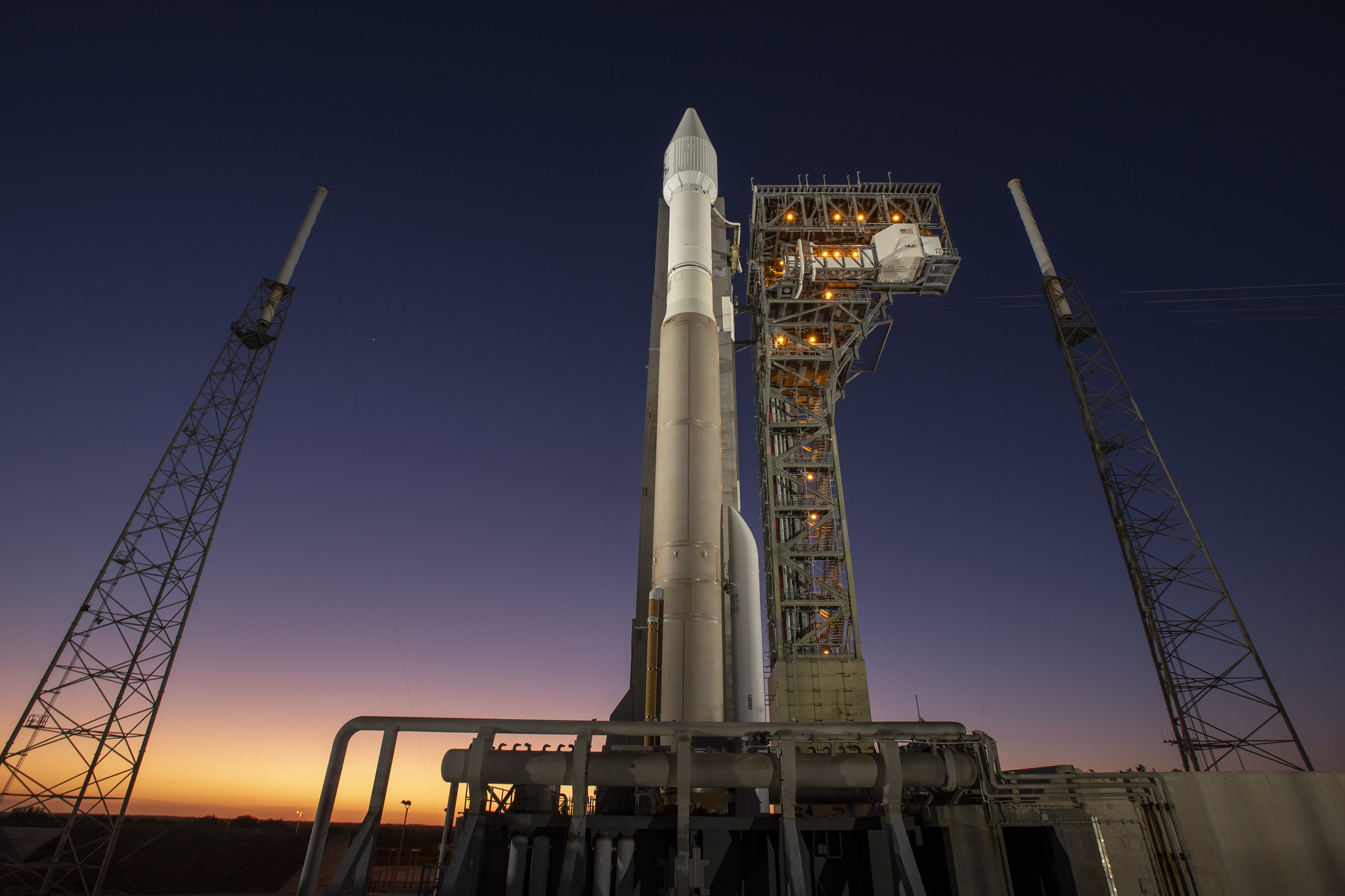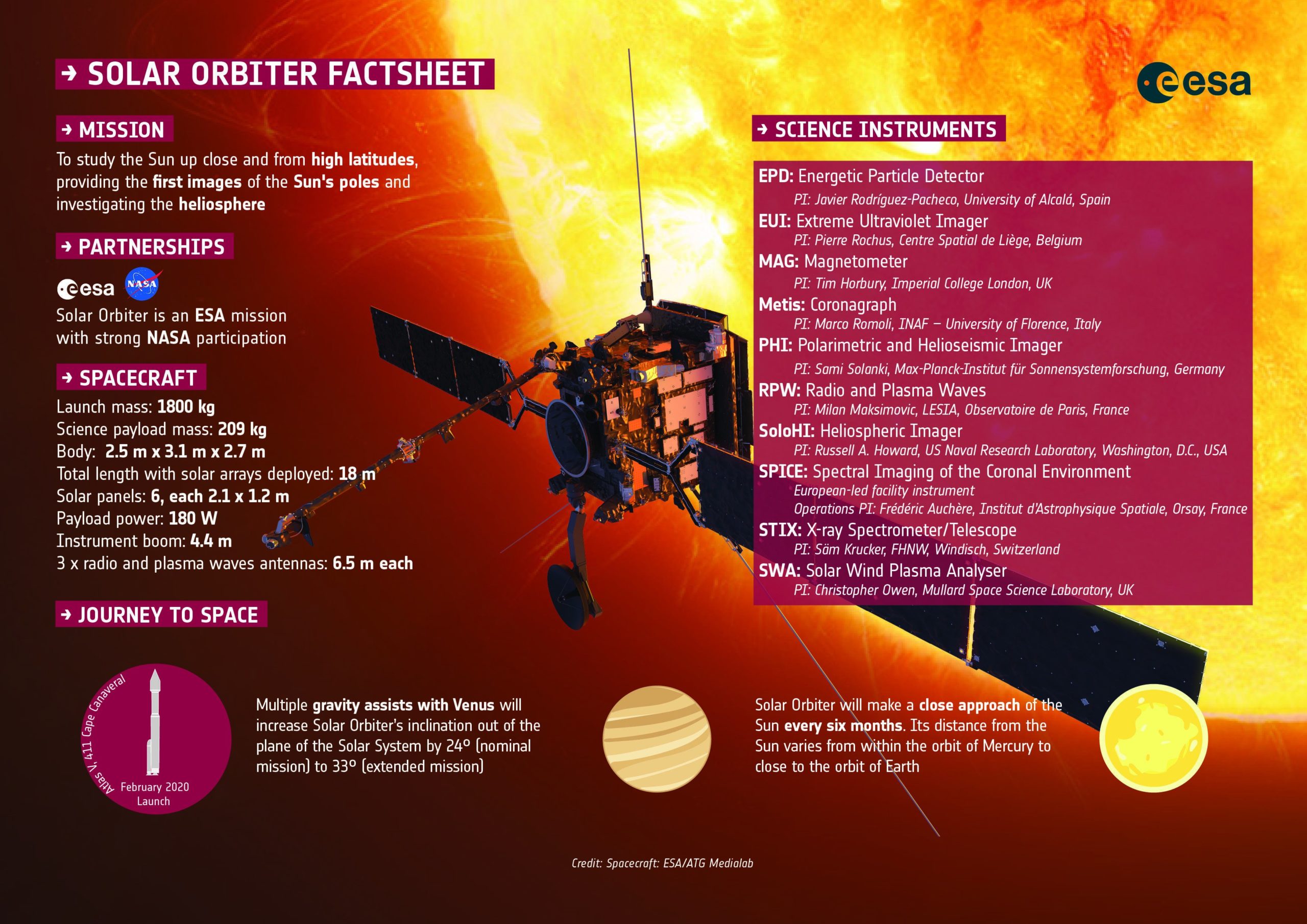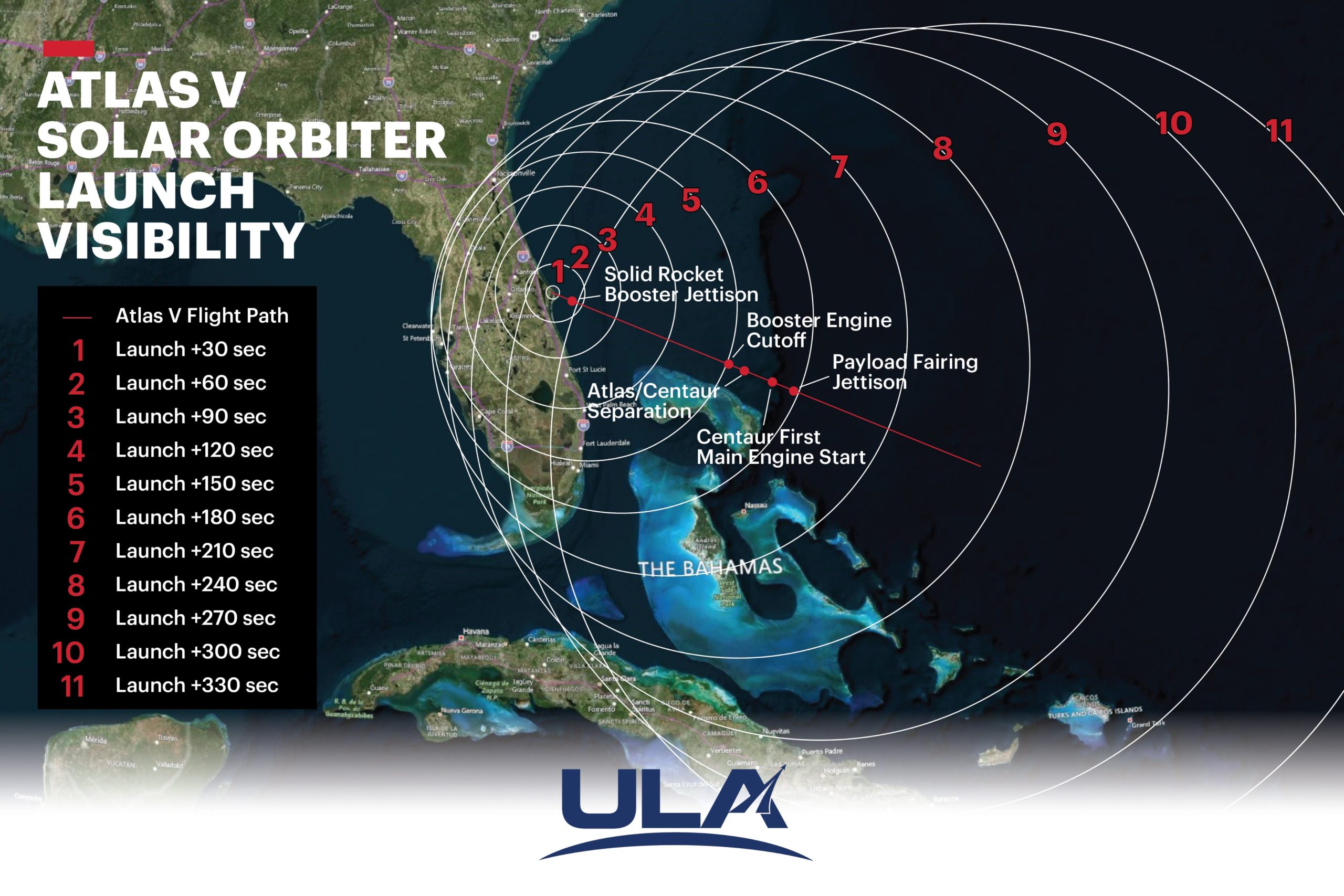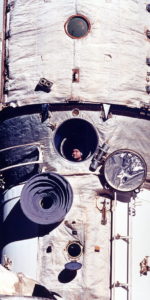
More than two decades since it was first conceived as a logical “next step” from the hugely successful Ulysses and Solar Heliospheric Observatory (SOHO) missions, Europe’s Solar Orbiter finally stands atop an Atlas V booster on Space Launch Complex (SLC)-41 at Cape Canaveral Air Force Station, Fla., ready to fly at 11:03 p.m. EST Sunday, 9 February.
This ambitious mission—which seeks to employ multiple Venus flybys to draw itself into a five-month elliptical orbit around the Sun that will bring it closer to our parent star than ever before and achieve the first close-range views of its poles—is spearheaded by the European Space Agency (ESA), but its complement of ten scientific instruments represents the collaborative efforts of solar scientists from several sovereign nations.
Watch the launch LIVE HERE on Sunday night beginning at 10:30pm EDT
The idea for Solar Orbiter originated in 1998 as a pair of concepts from Europe’s “Crossroads for European Solar and Heliospheric Physics” and it was formally selected by the ESA Science Programme Committee as a single “flexi-mission” in October 2000. Early plans called for it to fly atop a Soyuz-Fregat booster in the 2008-2013 timeframe and an initial workshop, held on the Spanish island of Tenerife in May 2001, served to develop and sharpen its scientific goals and demonstrated that Solar Orbiter was so important that its launch date should be advanced to 2010. And to achieve that date, it was quickly recognized that the spacecraft’s design philosophy—including advanced technologies for its thermal protection system—would do well to draw upon work already done in support of Europe’s Mercury-bound BepiColombo mission, then planned to fly in 2009.
Right from the start, Solar Orbiter was audacious in its scope. It would fly as close as 0.2 Astronomical Units (AU) of the Sun, grazing our star at 18.6 million miles (30 million km), deep inside the orbit of Mercury, incurring withering temperatures in excess of 520 degrees Celsius (970 degrees Fahrenheit). Using the gravitational aid afforded by repeated flybys of Venus, it would gradually establish itself into a five-month elliptical solar orbit and reach ever-increasing heliographic latitudes. This would allow it to conduct the first detailed, close-range observations of the Sun’s poles and examine solar emissions on a truly “global” scale for the first time. Although Ulysses performed several “fast-latitude scans” of the poles between 1994 and 2008, unlike Solar Orbiter its instrumentation dealt solely with fields-and-particles measurements and it carried no cameras or telescopes for visible imaging. Additionally, Ulysses never got any closer to the Sun than Earth itself—about 1.2 AU—whereas Solar Orbiter will draw far nearer for up to a decade of operational science.
But as the program got off the ground and moved into its assessment and definition stages, the critical obstacle was cost. Initially allocated a “cap” of some 200 million euros in 1999-2000 (approximately $230 million at the time), it was soon recognized that this was “less than adequate for such an ambitious mission”. By mid-2006, ESA’s Science Programme Committee considered options to build other spacecraft hardware in tandem with BepiColombo, maximizing synergy between them, as well as potentially bringing aboard international partners. One option was to merge Solar Orbiter with NASA’s planned Solar Sentinels program, but even at this point the launch date had slipped from October 2013 to May 2015 at the earliest. A workshop of solar scientists in Athens, Greece, concluded that even the latter of these target launch dates would only be attainable if “significant savings” were made in Solar Orbiter’s cost.
With the apparent likelihood of a joint venture with NASA, in March 2009 ten instruments were selected from 16 submitted proposals. Eight came from European investigators, with two more financed by the United States. These include a radio and plasma waves investigation from France, an energetic particle detector from Spain, an extreme ultraviolet imager from Belgium, an imaging and spectroscopy telescope from Italy, a polarimetric and helioseismic imager from Germany, an X-ray spectrometer telescope from Switzerland and the United Kingdom has supplied a magnetometer and solar wind and plasma analyzer. Meanwhile, NASA has funded an extreme ultraviolet spectral imager and a Naval Research Laboratory-built heliospheric imager.

These instruments reside on Solar Orbiter’s main bus, on an extendible boom or perched atop a set of three monopole antennas angled 90 degrees apart. The instrumentation occupies two groups, with some cross-over between them. The in-situ group of four instruments will monitor fields and particles in the vicinity of the spacecraft, whilst a remote-sensing group of six instruments will observe the Sun directly for about 30 days of each five-month solar orbit. They will do so via protected apertures cut through Solar Orbiter’s massive heat shield.
And that heat shield dominates the spacecraft. Ten feet (3.3 meters) long and eight feet (2.4 meters) wide, it will guard against thermal excesses as high as 520 degrees Celsius (970 degrees Fahrenheit) at perihelion and as low as -140 degrees Celsius (-220 degrees Fahrenheit) at aphelion. Its 15-inch (38 cm) thickness comprises several sheets of high-temperature insulation and titanium which will reject heat laterally into space through gaps between several layers. Solar Orbiter’s remote-sensing suite will examine the Sun through long titanium apertures cut through the shield, with protective baffles of toughened glass and beryllium. Temperatures will be so extreme at closest approach that the power-producing solar arrays must be carefully angled to avoid overwhelming their cells—or melting their adhesive glues—and even the high-gain antenna is expected to behave sporadically at varying distances from the Sun. As such, data will be routinely stored aboard the spacecraft and transmitted back to Earth at more stable portions of its orbit.

However, during the process to select Solar Orbiter’s instruments, NASA opted to delay implementation of its Solar Sentinels program in favor of Solar Probe Plus, eventually renamed the Parker Solar Probe and launched via a Delta IV Heavy booster in August 2018. In the meantime, in April 2012, Astrium UK (now part of Airbus) was awarded the 300-million-euro ($335 million) contract to build Solar Orbiter; one of the largest contracts ever signed between ESA and a UK-based company. And in March 2014, ULA’s venerable Atlas V was selected to launch the spacecraft. By this stage, however, launch had slipped inexorably to the right, firstly to July 2017, then October 2018 and eventually February 2020, to ensure that spacecraft systems were thoroughly tested for this most complex of missions.
Finally, in November 2019 Solar Orbiter arrived via an Antonov An-124 aircraft at the Kennedy Space Center (KSC) in Florida, having flown from Germany’s IABG engineering and test center, near Munich. It was transported directly to Astrotech’s space operations facility, near Titusville, for uncrating and several weeks of extensive tests. In the meantime, the components of its giant Atlas V rocket—the Common Core Booster (CCB) and Centaur upper stage—arrived in Florida from United Launch Alliance’s (ULA) facility in Decatur, Ala. Together with a single, solid-fueled booster, mounted to the side of the CCB, the complete stack was rolled out from the Vertical Integration Facility (VIF) to the SLC-41 pad surface last month for a fully-fueled Wet Dress Rehearsal (WDR). Delayed a couple of days, due to the need to replace a cold air duct, this conspired to push Solar Orbiter’s launch slightly past the 5 February opening of its 23-day “launch window”. Plans to fly on the 7th also came to nothing, when the rollout of the payload to the pad for installation stop the Atlas V was delayed by weather and SpaceX’s recent Starlink-3 mission.


Following launch, the 4,000-pound (1,800 kg) spacecraft will commence a 21-month “cruise” that will carry it past Venus in December 2020 and August 2021, then Earth the following November. These so-called Gravity Assist Maneuvers (GAMs) form part of an intricate celestial “dance” which will reduce its orbital energy and increase its heliocentric inclination, pulling it ever deeper into the Sun’s gravitational well and cranking up its heliographic latitude. The November 2021 flypast of Earth, in particular, will see Solar Orbiter skim past our planet at a distance of only 270 miles (430 km), affording a 23,940 mph (38,528 km/h) velocity boost.
Its final departure from Earth will officially mark the end-point of the cruise and the mission’s “science phase” will get underway. During this period, Solar Orbiter will execute additional Venus GAMs in September 2022, February 2025 and December 2026, each of which will further turbocharge its relative velocity and incrementally fine-tune its path into a 168-day elliptical solar orbit. This path will bring the spacecraft as close as 0.3 AU at perihelion and cause it to drift as far as 1.2 AU at aphelion. And it will serve to raise Solar Orbiter’s heliographic latitudes from a couple of degrees after the November 2021 flypast of Earth to around ten degrees by early 2023 and 25 degrees by the end of the primary science phase in late 2026. All being well, an “extended phase” is expected to follow, encompassing three more Venus GAMs in March 2028, June 2029 and September 2030, which should raise Solar Orbiter’s heliographic latitude as high as 34 degrees.
Principal focuses of the mission during up to a full decade of scientific service include deriving a better understanding of why solar coronal plasmas are hundreds of times hotter than the Sun’s visible “surface”, its photosphere, as well as the origin of the solar wind. Solar Orbiter will determine the properties, dynamics and interactions of plasmas, fields and particles in the near-Sun environment, as well as the links between the photosphere, corona and the inner heliosphere, as well as probing the hypothetical “solar dynamo” thought to induce the global magnetic field. At certain portions of its orbit, the spacecraft will achieve a state of “quasi-heliosynchronous rotation”—essentially matching the Sun’s rotation rate for a few days—which will permit it to uniquely “hover” over the surface and investigate phenomena as they evolve and develop.
.
.
FOLLOW AmericaSpace on Facebook and Twitter!
.
.
Missions » Solar Orbiter »




